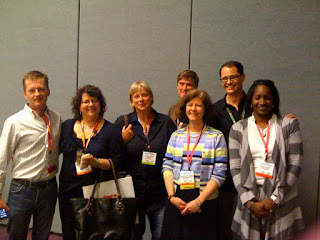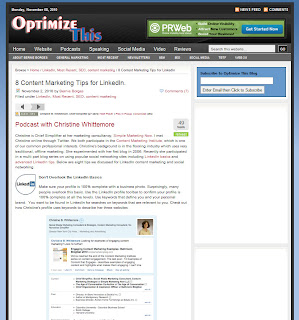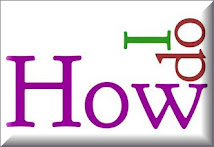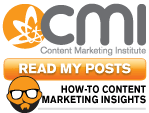The conversation about LinkedIn continues on the TalkFloor social media marketing interview series with Dave Foster.
In part I, we
introduced LinkedIn and examined features of LinkedIn.
In part II, we explored
advanced LinkedIn features such as Groups, Answers, Events and Search.
In part III, we examine LinkedIn business successes - practical examples of businesses using LinkedIn. The
TalkFloor interview is in three parts and aired October 25, 26 and 27, 2010.
Dave and I are both on LinkedIn, so please do connect with us:
Dave Foster and
Christine B. Whittemore. What follows are my show notes.
LinkedIn is a social network.
The best uses for LinkedIn involve connecting with others – to
build your reputation, recruit or make contact with, to do market research with, to establish thought leadership and generate new business with down the road. It’s a network of people, more specifically business professionals.
LinkedIn is not the best source of mass consumer leads. It is, however, a valuable B2B source and will connect with you professionals from around the globe allowing you a rich source for networking. LinkedIn is a powerful social networking platform as we discussed in the last session. It's considered the #1 resource for marketing your business.
For retailers, LinkedIn means connecting with:
- peers to consult with in a non-competitive environment.
- suppliers.
- valuable for B2B or commercial relationship building and to supplement/reinforce the networking you do at Chamber of Commerce meetings and other local groups.
Remember the rules for social networking. They apply to LinkedIn, too:
+ offer value
+ no hard sell
+ be active consistently
+ mind your manners
+ Don’t spam
+ remember that your reputation is at stake
+ think long term.
1. Build Your Business Reputation via LinkedIn
Offer value based on your area of expertise. As important as it is to fully understand your own company and products, if you want to connect with others – find commonality, develop a relationship, engage in conversation with them – it’s equally important to
think beyond products to solutions. You may be in the flooring business, but you also deal with business processes or marketplace issues that are relevant to other business people. Perhaps, too, your product fits into a bigger solution: flooring is part of a building, for example.
The poster child for building reputation via LinkedIn is Jason Alba who has written the book
 I'm on LinkedIn--Now What???: A Guide to Getting the Most Out of LinkedIn
I'm on LinkedIn--Now What???: A Guide to Getting the Most Out of LinkedIn
LinkedIn offers those who participate in LinkedIn Answers the opportunity to accumulate ‘reputation points’. To build your reputation via LinkedIn, take a topic of interest and knowledge to you. Maybe it’s environmental sustainability or time management.
Search for groups related to your category => participate.
Update your status regularly to reflect your theme
Search through LinkedIn Answers => participate to share insights and advice NOT TO SELL
Thank privately all those who comment and express interest.
Be consistent about sharing, have a theme. Is it all related to sustainability? Or is it sustainability in your town? Or related to one product?
Consider gathering what you share into a newsletter. [Think how to repurpose the content you create.]
2. Recruit for Business Using LinkedIn
In terms of case studies for recruiting, just about every company has turned to LinkedIn for recruiting. Either for hiring leads or to supplement candidate research by searching on specific keywords and connecting with those who have an interesting and relevant background. So, be prepared!
Another valuable idea with long term benefit is to create a group that brings together people with common interests – perhaps around a cause – and interesting backgrounds that may relate to your field of interest or expertise.
+ By inviting them, you make them feel good.
+ At some point down the road, this might be a group that you hire from or pull from for additional activities.
+ By creating such a forum, you create goodwill and readiness to help you when you need the help.
LinkedIn Business Examples:
+ Marvelous example of this is the #prstudchat group which supports a weekly PR student chat. The group is robust, active, further discussing ideas presented during the Twitter chat and representing talented young PR candidates.
+ Incept helps blood centers recruit and maintain blood donors to maintain a supply of blood. They created a customer-centric group around giving blood that connected people who work at blood centers around the country, discussed issues faced at blood centers and identified solutions [how to knowledge] and built relationships. Imagine how powerful this will be for the next blood crisis! [Read Nate Riggs' post:
How To Build a Customer-Centric LinkedIn Group.]
NOTE: remember to moderate and manage your groups. Don’t forget to set rules for behavior.
Develop the relationships first. Once you’re active in LinkedIn groups and answers, you’ll find that you can seamlessly turn to the relationships and goodwill that you’ve built for other purposes.
3. Market Research Using LinkedIn
Given the tools that LinkedIn makes available for asking/answering questions and engaging in discussions and conversations, don’t overlook LinkedIn as a source of valuable market research and insight.
For example, in the groups you’re active in, post a request/invitation to participate in your research.
Create an event [i.e., a research event] and invite others to the event.
Be sure to have a series of messages prepared explaining what you’re researching, thanking for participation. Etc.
Be sure to mine existing data on LinkedIn including existing Answers.
Read through relevant group discussions.
Connect with those whom you find insightful.
Build relationships.
4. Building you Business with LinkedIn
This one is near and dear to many of us as we try to figure out how to reach more customers, right?
The
New York Times recently featured a Canadian entrepreneur who sells equestrian luggage. It’s called Red Scarf Equestrian. She credits LinkedIn for building her business because it allowed her to expand beyond Canada.
How: by searching on relevant terms, finding groups related to her product category and building relationships.
As with building your business offline, this happens gradually over time.
It supports all of your offline or in-person activities and it allows you to connect in a way that overcomes location, makes the most out of the relationships you’ve built throughout your career.
It’s efficient.
Your LinkedIn Assignment:
Go explore.
Make a habit of spending 20 minutes a week on LinkedIn. Add a reminder to your Outlook calendar to do so.
Same as with networking offline: Start building relationships and establishing your reputation now so you earn enough social capital to make sales pitches down the road more acceptable.
Before heading off to Surfaces, do a LinkedIn search on some of the people you will be meeting with. Bring that information up when you meet. Observe what happens.
Please, let me know if you have any questions and also what you find most valuable as you create business successes using LinkedIn.
Other Resource:
Ann Handley on
How I was wrong about LinkedIn (with 2 Mini Case Studies)


























